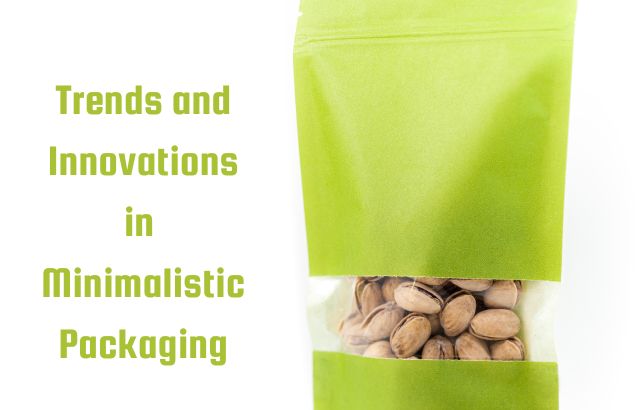Minimalistic Packaging and Green Innovation – In India, the wave of sustainability is sweeping across various industries, and packaging is no exception. Among the many shifts towards greener practices, minimalistic packaging designs have emerged as a significant trend. This approach emphasizes simplicity and efficiency, reflecting a growing awareness of environmental impact and resource optimization. Minimalistic packaging not only reduces material waste but also enhances functionality and promotes recycling. As brands increasingly recognize the benefits of streamlined and eco-friendly packaging solutions, the Indian market is witnessing a surge in innovative designs that align with global sustainability goals. In this context, let’s explore the latest trends and innovations in minimalistic packaging designs that are making a mark in India, illustrating how they contribute to a more sustainable future.
Trends and Innovations in Minimalistic Packaging Designs in India –

Eco-Friendly Materials
Biodegradable Materials: Indian brands are increasingly adopting biodegradable materials such as plant-based plastics, recycled paper, and organic fibers. For example, companies like EcoBosh and Paper Boat are using biodegradable and recycled materials for their packaging, reducing waste and environmental impact.
Simplicity and Functionality
Streamlined Designs: Many Indian brands are opting for packaging that is both simple and functional. Minimalistic designs often focus on eliminating excess and enhancing user experience. Brands like The Body Shop India are known for their clean and functional packaging that aligns with their eco-friendly ethos.
Reduced Use of Plastics
Alternative Packaging Solutions: There is a noticeable shift towards reducing plastic use. Haldiram’s and Amul have started incorporating more sustainable packaging options like paper-based or compostable materials instead of traditional plastic wrappers.
Eco-Conscious Branding
Branding with Purpose: Brands are increasingly integrating their commitment to sustainability into their packaging design. Sustainable Fashion brands like Doodlage and Upasana use minimalistic packaging to reflect their focus on reducing waste and promoting eco-conscious lifestyles.
Local and Handmade
Artisanal Packaging: There is a rising trend of using locally sourced and handmade packaging materials. For instance, The Good Stuff and Chumbak are incorporating traditional Indian craftsmanship into their packaging, making it both minimalistic and culturally significant.
Reusability and Recyclability
Design for Longevity: Many brands are designing packaging with the intention of reuse or easy recycling. Happi Mobiles has introduced packaging that customers can repurpose, while Patanjali has opted for recyclable materials to minimize environmental impact.
Consumer Education
Informative Labels: Minimalistic packaging often includes clear, informative labels that educate consumers about proper disposal and recycling. Brands like True Elements use minimalistic designs that prominently feature recycling information and eco-friendly practices.
Minimalistic Packaging and Green Innovation- Impact of Minimalistic Packaging in India

1. Environmental Benefits: By reducing excess packaging and utilizing sustainable materials, minimalistic designs contribute significantly to lowering waste and decreasing the carbon footprint.
2. Cost Efficiency: Simplified packaging can lead to cost savings in production and logistics, benefiting both brands and consumers.
3. Enhanced Brand Image: Brands that adopt minimalistic and sustainable packaging often enjoy a positive public perception and increased consumer loyalty.
4. Market Adaptation: As Indian consumers become more environmentally conscious, brands are adapting to these preferences by incorporating minimalistic designs that align with modern sustainability values.
Minimalistic Packaging : Insights from Jaiguru

1. What is minimalistic packaging?
Minimalistic packaging focuses on simplicity and functionality, using fewer materials and avoiding excessive design elements. It aims to be practical while minimizing environmental impact.
2. Why is minimalistic packaging important in India?
Minimalistic packaging helps reduce waste, lower production costs, and align with growing consumer demand for eco-friendly and sustainable products.
3. Are there specific brands in India known for minimalistic packaging?
Yes, brands like The Body Shop India, Haldiram’s, and Amul are known for adopting minimalistic and eco-friendly packaging designs.
4. How does minimalistic packaging benefit consumers?
It benefits consumers by providing clear, functional packaging that is often easier to recycle or reuse, while also supporting environmental sustainability.
5. Can minimalistic packaging be cost-effective?
Yes, minimalistic packaging can be cost-effective by reducing material costs and streamlining production processes, which can also lead to savings for consumers.
The Connection Between Minimalistic Packaging and Green Innovation

Minimalistic packaging is more than just a design trend; it is a pivotal aspect of green innovation. The principles of minimalism align closely with the goals of sustainability and environmental responsibility, making it a natural fit within the broader movement towards greener practices. Here’s how minimalistic packaging ties into green innovation:
1. Reducing Material Waste
Green Innovation Focus: Minimizing resource use and waste production.
Connection: Minimalistic packaging often involves using fewer materials, which directly reduces waste. By streamlining packaging to the essentials, brands can cut down on excess material use, thus lowering the overall environmental footprint. For instance, companies like Patanjali have adopted recyclable materials and simplified packaging designs to align with green innovation goals of waste reduction.
2. Enhancing Recycling and Reusability
Green Innovation Focus: Promoting recycling and circular economy principles.
Connection: Minimalistic packaging frequently incorporates materials that are easier to recycle or reuse. By using single-material packaging and clear labeling, brands facilitate better recycling processes. True Elements, for example, designs its packaging with a focus on recyclability, helping to support a circular economy where materials are continuously reused.
3. Lowering Carbon Footprint
Green Innovation Focus: Reducing emissions and energy consumption.
Connection: Simplified packaging often means fewer resources are needed for production, which translates into lower energy consumption and reduced carbon emissions. Haldiram’s has shifted towards more sustainable packaging options, contributing to a reduction in the carbon footprint associated with their products.
4. Encouraging Sustainable Consumer Behavior
Green Innovation Focus: Raising environmental awareness and encouraging eco-friendly choices.
Connection: Minimalistic packaging often includes clear, informative labels about proper disposal and recycling, educating consumers about sustainability. Brands like The Body Shop India use packaging to reinforce their commitment to eco-friendly practices, encouraging consumers to make more environmentally conscious choices.
5. Supporting Local and Sustainable Practices
Green Innovation Focus: Promoting local sourcing and sustainable production methods.
Connection: Many minimalistic packaging solutions incorporate locally sourced and sustainable materials. Doodlage and Upasana use traditional craftsmanship and eco-friendly materials, supporting local economies and sustainable production practices while minimizing environmental impact.
6. Cost Efficiency and Resource Optimization
Green Innovation Focus: Streamlining processes and optimizing resource use.
Connection: Minimalistic packaging reduces material and production costs, which can be reinvested into further green innovations. Brands like Chumbak and The Good Stuff are able to maintain a sustainable approach while optimizing their resources, aligning financial efficiency with environmental responsibility.
Conclusion

Minimalistic packaging embodies the principles of green innovation by focusing on reducing waste, enhancing recyclability, lowering carbon footprints, and supporting sustainable practices. As more Indian brands embrace this approach, they contribute to a larger movement towards environmental stewardship and resource efficiency. In essence, minimalistic packaging is not just a design choice but a significant component of a broader green innovation strategy, driving both environmental and economic benefits.












